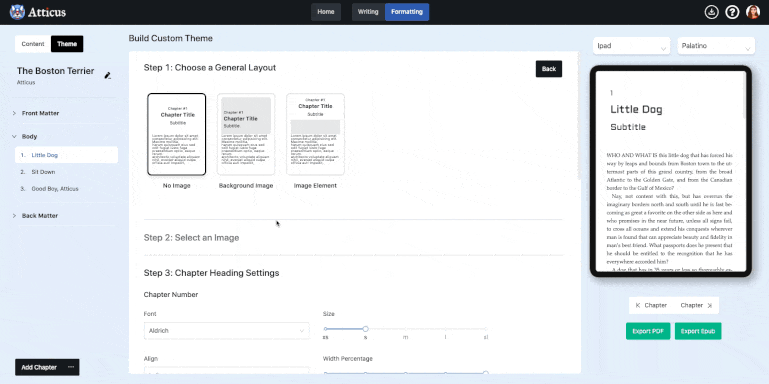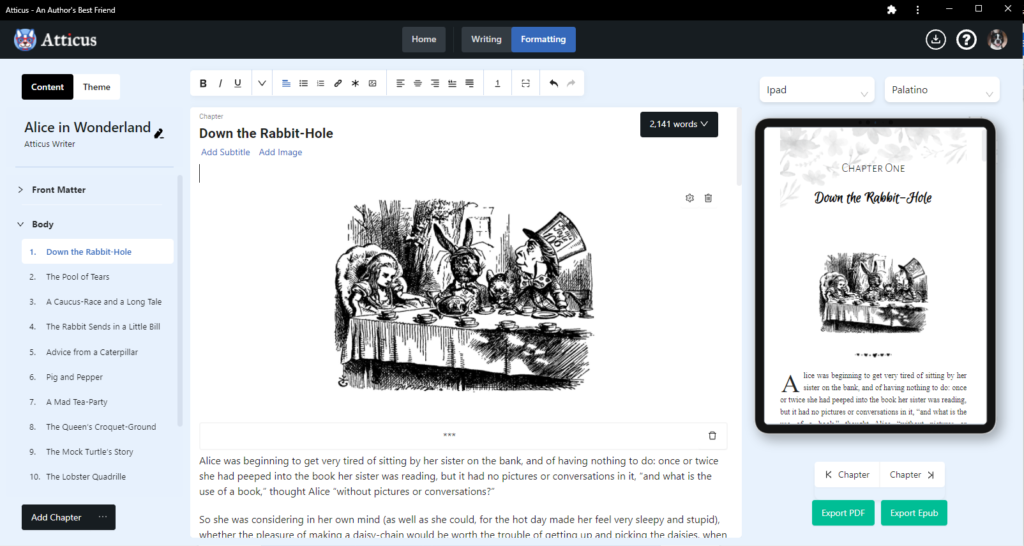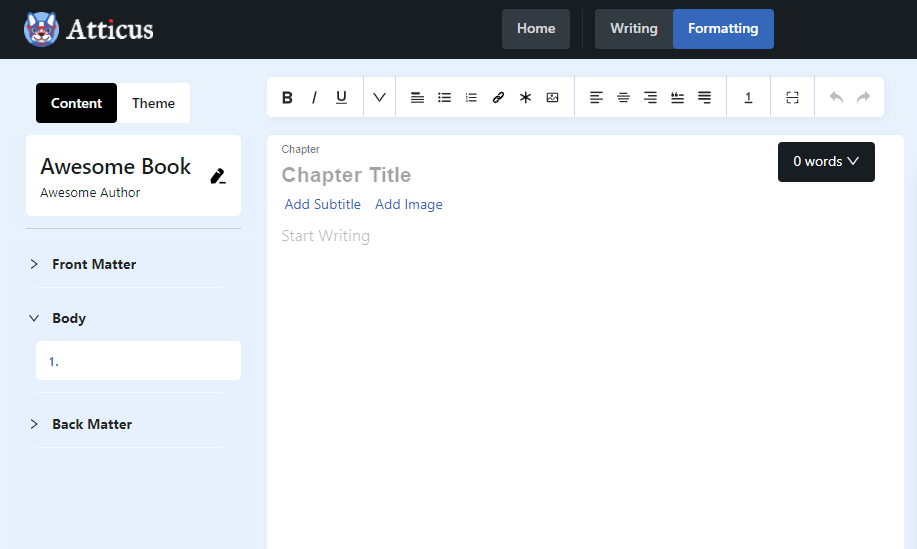If you are an author who wants to self-publish your work, then you might want to check out Atticus.
This online tool claims to offer everything you need to write and format your book, from start to finish. But can it actually deliver?
In this review, we will discuss the features that make Atticus so unique and helpful for authors, and why it is definitely a program that you should consider investing in.
But first, let’s start with some of the basics…
What is Atticus?
Atticus is an online tool that helps authors write and format their books. It offers a wide range of features, encapsulated under two main categories:
- A word processor with all the bells and whistles you need to write your book
- A book formatting tool that makes it easy to format your book for publication
Before, you would have to have two separate programs to do this. A lot of authors use Scrivener as their main word processor, or they use Microsoft Word or Google Docs.
Furthermore, Vellum has been the unquestioned champion of the book formatting space for a long time. But all that is starting to change.
While Atticus is shaping up to be an all-in-one writing tool, it is primarily a book formatter as of the time of this writing (there are a lot of updates to come). And that is where it excels.
Why Is Atticus a Big Deal?
Atticus is a relative newcomer to the world of software for authors, but it has already made itself a major player in this space.
For one, it was developed by Dave Chesson, the developer behind Publisher Rocket. Due to past experiences with Publisher Rocket, and Dave’s website, Kindlepreneur.com, it is clear that Dave knows the industry and understands the needs of authors.
Secondly, Atticus is the first real competitor to Vellum, which has until recently been the only exceptional formatting program on the market. But Vellum came with two downsides: it was very expensive, and it was only available on Mac.
That brings us to two amazing reasons why Atticus is a big deal:
- It is $100 cheaper than Vellum.
- It is available on almost all platforms, including:
- Windows
- Mac
- Linux
- Chromebook
Add to that the fact that Atticus is a writing software as well, whereas Vellum is purely a formatting software, and you’ve got a really great deal.
There are also some future features that we are incredibly excited about. Most importantly…
Collaboration
Right now, there is not a good way to collaborate with other authors when writing your books. The best way to do this, currently, is to use Google Docs. But Google Docs can be clunky when writing a book, and it would be really nice if a more robust writing program like Scrivener had a way to do this.
Well, one of the huge features to come on Atticus is the ability to collaborate, not just with other authors, but also with your editors and proofreaders.
I wouldn’t normally talk about future plans for a software in a review like this, but this feature is shaping up to be a complete game changer. No more sending files back and forth to your collaborators, and marking everything as Draft2_FINAL_FINAL, or something like that. Everything can just remain inside Atticus.
How Much Does Atticus Cost?
Atticus has a lifetime price of $147. Additionally, you get all future updates at no extra charge. There is no subscription price, which we find amazing, because who wants to pay a subscription price to write their books, only to potentially lose those books if you can no longer pay the subscription?
With Atticus, you will have this software for life.
Is There a Free Version?
There is not a free version or a free trial of Atticus. However, there is a 30-day money-back guarantee, so if you find that you don’t enjoy the program, you can get a rebate during those 30 days.
Atticus Features Overview
So let’s talk about the specific features that Atticus has, and why they are important.
Atticus has four core features that I want to highlight:
- The chapter theme builder
- Formatting a book in Atticus
- Writing a book in Atticus
- It’s cloud versus offline usage
Let’s take a look at all four of these, one by one.
1. The Chapter Theme Builder
While we could file this under the next section of formatting a book in Atticus, we thought it deserved its own section.
With Atticus, you are able to create beautiful chapter themes for your book. This may not sound like a huge deal, but it is.
And we’re not just talking about the font or size of your chapter titles, we are talking about full spread images, images that change from one chapter to another (think Harry Potter), and more.
The images, in particular, are pretty cool. There are two different types:
- Image elements: this is where you can add an image above or below your title and subtitle. You can have the same image for every chapter or make them different. I like the idea of subtly changing each chapter image, like showing a countdown clock or something.
- Full-bleed images: with full-bleed images, you can create a design that goes all the way to the edges of your book (this is obviously for print books and not for e-books). This can create a great background effect for your text, and Atticus even has a dark mode that lets you have white text on a darker background for your chapter header.
And if all of this sounds overly complicated, Atticus comes with a lot of different pre-built themes that let you take a standard, unobtrusive style and run with it.
2. Formatting a Book In Atticus
As we mentioned before, formatting a book is where Atticus shines. It has all of the capabilities of Vellum, including some of the following:
- You can customize everything: whether it’s the font style, the font size, the images, or selecting which elements you want to have, Atticus is able to tweak all of it. And if that’s too much, there are templates to get you started.
- Customizable ornamental breaks: ornamental breaks are those little icons you see between scenes that aren’t full chapter breaks. Atticus has a wide selection, or you can upload your own.
- Export options: Atticus doesn’t have a huge selection of export options, but it can export to EPUB, DOCX, and PDFs, which is about all you need.
- Import options: like the export options, Atticus doesn’t have many of these (yet), but you can import DOCX and RTF files to easily load your book into Atticus.
- Device previewer: in the formatting tab, you can see exactly what your book will look like for both digital devices and in print form. This also lets you know exactly how many pages your book will be, and you can download PDFs of your individual chapters.
- Large print: if you want to create large print books for your readers, which involves a lot more than just creating a book with a bigger font, Atticus has you covered. It lets you select large print options, and the rest is taken care of for you.
- Full-page images: If you want to have an image take up a full page in your book, you can add those as well. You can also tell Atticus whether you want these to be full bleed (i.e. extending to the edges of your print book pages) or just a large image.
There are a lot of little nuances to the formatting features in Atticus, but these were the big ones that we wanted to highlight. Covering every small detail would take an article much longer than this one.
3. Writing a Book in Atticus
Atticus is not just a formatting tool, you can also write your book in it. Here are some of the more important features related to writing your book that we thought were interesting.
- The word processor: the word processor is about what you would expect. You will find similar things in Scrivener, Google Docs, or WordPress. While it is more simple than these applications, it does come with everything you need for fiction and nonfiction writing.
- Word count: within each chapter, you are able to see the word count of that chapter, as well as the word count for the entire book, or of a specific selection.
- Goal setting: if you want to really get yourself fired up about writing, the goal setting features allow you to gamify the process and set project-based goals, or develop a daily writing habit.
- Writing preferences: let’s say you are dyslexic, and you want a specific font to write with that is different from the font your book will be printed in. No problem! Atticus lets you set whatever font you want, just for the writing. You can even write in comic sans, which is actually a good font for editing. In fact, we recommend editing in a different font from what you write in.
- Spell check and ProWritingAid: Atticus comes with your standard spellchecker, but if you want to go the extra mile, you can get ProWritingAid and integrate it with Atticus. The two work together quite well.
- Front and back matter: Atticus makes it easy to identify the different “elements” of your book, from the front matter like your preface and introduction, to the back matter like your author bio. Organizing these elements is quite easy.
- Reusable elements: this is one of my favorite features. With reusable elements you can create a standard template, such as an author bio, and reuse that same element over and over again in multiple books. The best part is that if you changed that element, you can choose to change it for all of the other books that use it.
Atticus still has a little ways to go before they are as robust as Scrivener, but for those who don’t require anything fancy, Atticus works quite well as a writing program in addition to a formatting program.
4. Cloud Versus Offline Usage
Atticus is primarily a cloud-based system. While that might turn a few people off, it does have some offline capabilities. Since Atticus is a progressive web app (PWA), you can download it and install it on your computer. From there, you can access your books offline.
However, Atticus is not a fully-offline program. You will need to be online when you initially login, and if you want to export a book. Other than that, you can work completely offline.
But, given what I know of the collaboration features coming in the future, you will have to be online for those, and with good reason. Atticus is basically a little bit of Scrivener, a little bit of Vellum, and a little bit of Google Docs all rolled into one.
Verdict: Is Atticus Worth It?
For authors looking for a cheaper alternative to Vellum, or for those who use a PC, Atticus is definitely worth it.
Not only is Atticus a cheaper program than Vellum, but it also comes with the ability to write your books within the software, and has new features on the horizon that will easily make it the most competitive tool of its kind.
Atticus has everything you want in a formatting program, much of what you want in a writing program, is available on virtually every platform, and is far more affordable than the leading alternatives.
The only downside is that it is not a fully-offline program, but there are benefits to that as well, most notably the upcoming collaboration features (which we are really excited about).
In short, for most authors, we recommend you take a look.




I tried Atticus about half a year ago and found it unusable for writing. The screen wouldn’t advance with the cursor, meaning that I had to hit Ctrl + End to see my cursor (and what I was typing) every time my cursor moved beyond the bottom of the screen. I contacted customer support about what I assumed was a big, and I was shocked to find out that this was a “feature” that was on the horizon. Customer service was prompt and they offered me a full refund without any trouble. Does anyone know if cursor advancement had been added yet? I was also surprised to find that software with such obvious limitations was offered to the public in the first place. Has anyone found any more of these missing “features” that makes this software unusable for basic writing?
I’m definitely interested in a product like this, an all-in-one solution to publishing. It’s hard to believe that there aren’t viable options or there given the market.
Very well-written article–as usual. I will definitely check out Atticus. Thanks for the info.
Dave is an engineer by training and comes up with better tools for authors than anyone else I’ve found. I love Atticus.
There were a few bugs at first, but they were quickly fixed and features continue to be added. Paid for itself with the first novel I published and was flexible enough to support my “wide” needs.
Dave Chesson did Publisher Rocket as well, which is my favorite tool of all.
Have been using Atticus for two weeks now …. on Windows 11 Laptop.
My first book from it is already on Amazon
Just one word for this review …. Brilliant
I tried Atticus early 2023 and found the basic word processing to rudimentary, limited to a single font size. I don’t see 12 point the only size available at the time well due to a head injury. So in WORD write in 18 point.
I understand this has been fixed so this week (June 18 2023) will upload a 50,000 word novel and try again. I have a-lot of faith in Dave Chesson to deliver on adding features. Just hope he keeps it simple unlike Scrivener.
I love this software and am still learning where things are. It works with Pro Write, but you can edit in Word. I am in the process of drafting a novel now. I love the options for themes as it makes the content look very professional. I like being able to insert images in the chapters. I am still looking for the number of pages, but I will find it.
I just got Atticus. so far I am major disappointed. The reason I bought it was to simply formatt from word.
the tutorial videos are hard to understand. It says click view on the menu then go to navigation panel. how do I get to this menu? it’s like pulling teeth